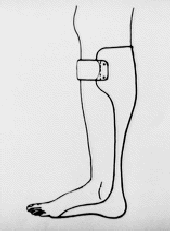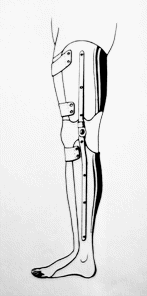


An ankle-foot orthosis (AFO) is an externally applied orthopedic appliance which is designed to protect, support and prevent or correct deformity of the foot, ankle and lower leg complex. AFOs are commonly refered to as braces or splints and can be made from either plastics or metal and leather. Various hinge designs are also available for AFOs which allow articulation at the ankle joint. New advances in design are an ongoing process.
AFOs are commonly used to provide support for footdrop or for ankle instability associated with several conditions some of which include stroke, spina bifida, cerebral palsy, Lou Gehrig's Disease(ALS), multiple sclerosis, paraplegia or polio.
AFOs come in both prefabricated and custom-made versions and the appropriateness of each design is determined by the type of deformity and functional levels of the individual.
A knee-ankle-foot orthosis (KAFO) is an externally applied orthopedic appliance which encompasses the foot, ankle, lower leg, knee and thigh. The KAFO provides the features of an AFO but in addition provides protection, correction and support of the knee joint.
Some KAFOs are still made from metal and leather but most designs now use thermoplastics with metal only being used for the hinges at the knee. The lightweight plastic designs offer more support, are more cosmetically acceptable and can fit into various shoe designs. While the metal braces are more adjustable, they tend to be heavier, bulkier and require special attachments for fitting to shoes. A heavier shoe is also generally required when using the metal brace. Very lightweight carbon fibre designs also exist but are not economical, lack adjustability and are rarely more suitable than thermoplastic designs.
KAFOs are commonly used to treat symptoms due to spina bifida, cerebral palsy, paraplegia, polio, trauma or muscular dystrophy.
KAFOs with a knee lock are generally used to keep the knee from bending when there is a loss of or weakness of the muscles(quadriceps) that straighten the knee. When there is adequate strength and only support of the ligaments is needed as in sports injury, the lock and foot section are not needed. Such a device is called a knee brace or orthosis.
KAFOs and knee braces come in various designs and the appropriateness of each design is determined by the type of deformity and functional levels of the individual.
A hip-knee-ankle-foot orthosis (HKAFO) consists of a trunk section connected to two KAFOs by two lateral hip joints. These joints usually have locks that can be disengaged for sitting. Movement with an HKAFO is achieved by a swing through or hopping type gait with the assistance of either a walker or forearm crutches with both legs are moved together as one unit.
A reciprocating gait orthosis (RGO) is also a HKAFO however it allows one leg to be placed ahead of another - more like normal walking. This is achieved by linking the two KAFOs together by a band, two cables or a push-pull rod which transfers movement energy from one leg to the other (see diagram). Therefore as one leg is flexed or brought forward, it causes a reciprocal extension of the other leg. This allows a much smoother gait and greatly reduces the amount of effort that is needed to walk. A walker can often be abandoned for forearm crutches.
RGOs tend to be most successfully used for children with spina bifida starting as young as 2.5 years old but have been used by children with other diagnoses. RGOs are sometimes used for adult paraplegics but often a wheelchair becomes the preferred mode of transportation for the adults.
The RGO is commonly used for individuals with a lesion level of T12 to L3 (although higher levels are possible) who lack adequate strength to maintain hip extension. Good upper extremity strength, high motivation levels, good family support and minimal contractures definately contribute to the successful use of the device.
